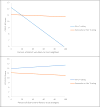High social trust associated with increased depressive symptoms in a longitudinal South African sample
- PMID: 29232620
- PMCID: PMC5790319
- DOI: 10.1016/j.socscimed.2017.12.003
High social trust associated with increased depressive symptoms in a longitudinal South African sample
Abstract
Several studies have documented a protective association between social trust and mental and physical health, but gaps in knowledge remain. Debates regarding the contextual versus individual nature of social trust are ongoing; research from low- and middle-income countries is lacking, and study designs have been limited for causal inference. To address these gaps, we examined the association between social trust and depressive symptoms using three waves of the National Income Dynamics Study, a longitudinal South African survey. We used individual fixed-effects models to assess the association between changes in scores on the Center for Epidemiological Studies Depression Scale Short Form (CES-D-10) and in individual-level and district-level personalized and generalized trust among 15,670 individuals completing at least two waves of the NIDS adult questionnaire. High individual-level generalized trust was unexpectedly associated with increased depressive symptoms scores while district generalized trust did not show an association. We also found a cross-level interaction between individual and district-level personalized trust. High individual trust was associated with increased depressive symptoms scores when district trust was low; however, as district-level trust increased, higher individual trust was associated with reduced depressive symptoms. Our unexpected results suggest that trust may not always be beneficial for depressive symptoms, but rather, that its effects may depend on context. In the South African setting where social trust is low, being very likely to trust may be associated with worse depressive symptoms in some circumstances.
Keywords: Depression; Fixed effects; Longitudinal; Social capital; South Africa; Trust.
Copyright © 2017 Elsevier Ltd. All rights reserved.
Figures


References
-
- Ardington C, Case A. Health: Analysis of the NIDS Wave 1 Dataset: National Income Dynamics Study 2009
-
- Bassett E, Moore S. Social capital and depressive symptoms: the association of psychosocial and network dimensions of social capital with depressive symptoms in Montreal, Canada. Social Science and Medicine. 2013;86:96–102. - PubMed
Publication types
MeSH terms
Grants and funding
LinkOut - more resources
Full Text Sources
Other Literature Sources
Medical

